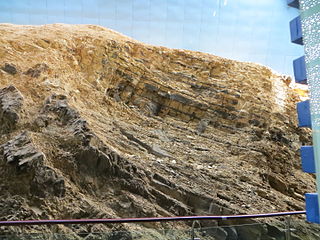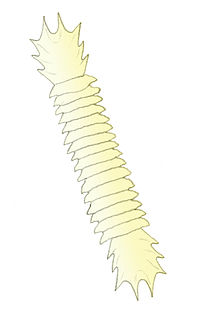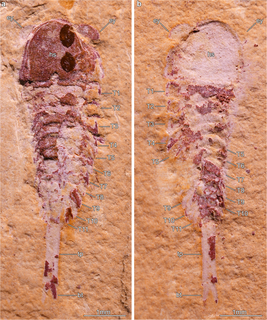
The Maotianshan Shales are a series of Early Cambrian deposits in the Chiungchussu Formation, famous for their Konservat Lagerstätten, deposits known for the exceptional preservation of fossilized organisms or traces. The Maotianshan Shales form one of some forty Cambrian fossil locations worldwide exhibiting exquisite preservation of rarely preserved, non-mineralized soft tissue, comparable to the fossils of the Burgess Shale. They take their name from Maotianshan Hill in Chengjiang County, Yunnan Province, China.

The Emu Bay Shale is a geological formation in Emu Bay, South Australia, containing a major Konservat-Lagerstätte. It is one of two in the world containing Redlichiidan trilobites. The Emu Bay Shale is dated as Cambrian Series 2, Stage 4, correlated with the upper Botomian Stage of the Lower Cambrian.

Fuxianhuia is a genus of Lower Cambrian fossil arthropod known from the Chengjiang fauna in China. Its purportedly primitive features have led to its playing a pivotal role in discussions about the euarthropod stem group. Nevertheless, despite being known from many specimens, disputes about its morphology, in particular its head appendages, have made it one of the most controversial of the Chengjiang taxa, and it has been discussed extensively in the context of the arthropod head problem.

Urokodia aequalis is an extinct genus of arthropod from the early Cambrian. The taxon is only known from the Maotianshan Shales of China based on some 15 specimens. Its segmentation resembles that of a millipede and it possessed head and tail shields with thorny spikes. It has some similarities to the arthropod Mollisonia that is known from both the Burgess Shale of Canada and the Kaili biota of China. Recently, the taxon has been considered a member of the order Mollisoniida, alongside Mollisonia, Thelxiope, and Corcorania, the group are suggested to be stem-chelicerates.
A number of assemblages bear fossil assemblages similar in character to that of the Burgess Shale. While many are also preserved in a similar fashion to the Burgess Shale, the term "Burgess Shale type fauna" covers assemblages based on taxonomic criteria only.

Acanthomeridion is an extinct arthropod found in the Chengjiang fauna deposits of China. In 1997, it was placed in its own, monotypic family, Acanthomeridiidae. It is known from eight specimens, all found in China.
Clypecaris is genus of bivalved Cambrian arthropod known from the Chengjiang biota. The genus was initially described for the type species C. pteroidea by Hou, 1999. A second species C. serrata was described by Yang et al in 2016.
Ercaicunia is genus of Cambrian arthropod known for being a member of the Chengjiang biota, containing the single species E. multinodosa. It was described by Luo et al in 1999. Specimens were CT scanned in 2019, which revealed it to be a stem-group crustacean.

Haikoucaris is a genus of megacheiran arthropod that contains the single species Haikoucaris ercaiensis. It was discovered in the Cambrian Chengjiang biota of China.

Isoxys is a genus of extinct, pelagic bivalved arthropod; the various species may have been roam-swimming predators. It had a pair of large spherical eyes, and two large appendages It is possible that these appendages are homologous to the great appendages of radiodonts and megacheirans.

Jianshania is genus of Cambrian arthropod known from the Chengjiang biota, containing the single species J. furfactus. It was described by Luo et al in 1999. In 2020, a specimen originally assigned to the species was found to represent the separate fuxianhuiid taxon Xiaocaris pending revision of the type specimen.

Kuamaia is an extinct genus of artiopodan in the phylum Arthropoda. Fossils of the type species K. lata were discovered in the Chengjiang biota. The other species in the genus,K. muricata has also been identified there, but neither species has been found elsewhere.
Kunmingella is genus of Cambrian bradoriid from the Chengjiang biota, containing the single species K. douvillei.
Kunyangella is genus of Cambrian arthropod known for being a member of the Chengjiang biota, containing the single species K. cheni. It has a bivalved carapace and has tentatively been referred to the Bradoriida.

The Artiopoda is a grouping of extinct arthropods that includes trilobites and their close relatives. It was erected by Hou and Bergström in 1997 to encompass a wide diversity of arthropods that would traditionally have been assigned to the Trilobitomorpha. Hou and Bergström used the name Lamellipedia as a superclass to replace Trilobitomorpha that was originally erected at the subphylum level, which they considered inappropriate.

Strabops is a genus of strabopid, an extinct group of arthropods. Strabops is known from a single specimen from the Late Cambrian of the Potosi Dolomite, Missouri, collected by a former professor, Arthur Thacher. It is classified in the family Strabopidae of the monotypic order Strabopida, a group closely related to the aglaspidids with uncertain affinities. The generic name is composed by the Ancient Greek words στραβός, meaning "squinting", and ὄψῐς, meaning "face".

Paleomerus is a genus of strabopid, a group of extinct arthropods. It has been found in deposits from the Cambrian period. It is classified in the family Strabopidae of the monotypic order Strabopida. It contains two species, P. hamiltoni from Sweden and P. makowskii from Poland. The generic name is composed by the Ancient Greek words παλαιός (palaiós), meaning "ancient", and μέρος (méros), meaning "part".

Squamacula is an extinct artiopodan arthropod from the Cambrian Series 2. The type species S. clypeata was described in 1997 from the Chengjiang biota. At the time of description there were only two known specimens of S. clypeata, but now there are at least six known specimens. In 2012 a second species S. buckorum was described from the Emu Bay Shale of Australia.

Sinoburius is an extinct genus of Xandarellid artiopodan known from the Cambrian aged Chengjiang Biota of China. It is only known from the type species S. lunaris, which was described in 1991. It is a rare fossil within the Chengjiang assemblage. Like other Xandarellids, Sinoburius has an unmineralised exoskeleton. Adult individuals are around 7-8 millimetres in length, with stalked eyes present on the ventral side.

Xandarella is an extinct genus of xandarellid artiopodan known from the Cambrian of China and Morocco, the type species Xandarella spectaculum was described in 1991 from the Cambrian Stage 3 aged Chengjiang Biota in China. An additional species Xandarella mauretanica was described from the Cambrian Stage 5 Tatelt Formation in Morocco in 2017, which only preseved the ventral anatomy. Like other Xandarellids, the exoskeleton is unmineralised. The cephalon has pronounced eye slits, presumably derived from ancestral ventral stalked eyes.















